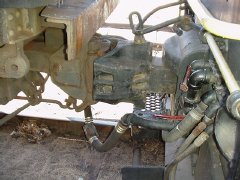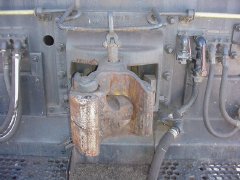 The
purpose of the couplers is to join the locomotive to the car behind it,
and to join each of the cars in the train to each other. Major Eli
Janney,
a Confederate veteran of the Civil War, invented the knuckle coupler in
1868. This semi-automatic device locks upon the cars closing together
without
the rail worker getting between the cars. This replaces the "link and
pin"
coupler, which was a major cause of injuries to railroad workers. A
"cut"
lever at the corner of the car releases the coupler knuckle making
uncoupling
safer.
The
purpose of the couplers is to join the locomotive to the car behind it,
and to join each of the cars in the train to each other. Major Eli
Janney,
a Confederate veteran of the Civil War, invented the knuckle coupler in
1868. This semi-automatic device locks upon the cars closing together
without
the rail worker getting between the cars. This replaces the "link and
pin"
coupler, which was a major cause of injuries to railroad workers. A
"cut"
lever at the corner of the car releases the coupler knuckle making
uncoupling
safer.  The locking pin is visible in the
center of this photo. When the cut lever
and pin are raised the coupler is allowed to open, as shown here. The
cut
lever is on either side of the coupler. In the upper photo the pin is
in
the lowered position, which keeps the couplers locked together,
allowing
the locomotive to pull the train.
The locking pin is visible in the
center of this photo. When the cut lever
and pin are raised the coupler is allowed to open, as shown here. The
cut
lever is on either side of the coupler. In the upper photo the pin is
in
the lowered position, which keeps the couplers locked together,
allowing
the locomotive to pull the train.
Have you ever heard the phrase "It was so quiet you could hear a pin drop"? This is a reference to this coupler pin! If the engineer and brakeman work together so that the coupling is accomplished gently, the couplers join together so that the pin drops quietly enough to hear it go "clink". This phrase is one of many that originated on the railroad.
Videos of coupling and uncoupling at the Campo Railroad Museum
Thanks to engineer Bob
Nickles
and brakeman Dave Houk.
Approach MPEG1 (2 MB)
The locomotive approaches the passenger car. The brakeman stops the movement 50' or more from the car for the required safety stop.Joint with passenger car MPEG1 (4 MB) or MPEG2 (44 MB)
The brakeman brings the locomotive in for the joint, then once made has the engineer back up to test the joint. This is called a "stretch.""Going in" MPEG1 (2 MB)
The brakeman asks for permission to "go between" in order to connect the air hoses. Once given permission by the engineer he kneels down so he can connect the glad hands together.Uncouple from passenger car MPEG1 (2 MB)
The brakeman lifts the cut lever so that the couplers open up. The locomotive now pulls away from the car.Joint with freight car MPEG1 (5 MB) or MPEG2 (41 MB)
The brakeman brings the locomotive in for the joint with a freight car, then has the engineer back up to test the joint.Uncouple from freight car MPEG1 (3 MB)
The brakeman lifts the cut lever so that the couplers open up. The locomotive now pulls away from the freight car, and since the car's air brakes were charged, there is an emergency application.
Daytime hand signals used by brakemen.
After-dark lantern signals used by brakemen.
Page by Randy Houk, updated 8 June 2013